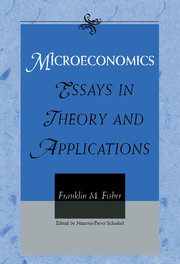Book contents
- Frontmatter
- Contents
- Introduction
- Part I Disequilibrium and Stability
- Part II Welfare Economics and Consumer Theory
- Part III Applications of Microeconomic Theory
- 19 On Donor Sovereignty and United Charities (1977)
- 20 A Proposal for the Distribution Abroad of the United States' Food Surplus (1962)
- 21 A Theoretical Analysis of the Impact of Food Surplus Disposal on Agricultural Production in Recipient Countries (1963)
- 22 US Experience: The Recent INS Study (1970)
- 23 Aspects of Cost-Benefit Analysis in Defence Manpower Planning (1969)
- Part IV Industrial Organization, Economics, and the Law
- Part V Public Policy Applications
- Epilogue
- Indexes
20 - A Proposal for the Distribution Abroad of the United States' Food Surplus (1962)
Published online by Cambridge University Press: 20 March 2010
- Frontmatter
- Contents
- Introduction
- Part I Disequilibrium and Stability
- Part II Welfare Economics and Consumer Theory
- Part III Applications of Microeconomic Theory
- 19 On Donor Sovereignty and United Charities (1977)
- 20 A Proposal for the Distribution Abroad of the United States' Food Surplus (1962)
- 21 A Theoretical Analysis of the Impact of Food Surplus Disposal on Agricultural Production in Recipient Countries (1963)
- 22 US Experience: The Recent INS Study (1970)
- 23 Aspects of Cost-Benefit Analysis in Defence Manpower Planning (1969)
- Part IV Industrial Organization, Economics, and the Law
- Part V Public Policy Applications
- Epilogue
- Indexes
Summary
One of the more embarrassing by-products of the United States' farm problem has been the accumulation in recent years of stocks of surplus crops. These surpluses enable others to picture the United States as hoarding food while millions in other lands go hungry. For some time it has been evident that it would be highly desirable to use the United States' farm surplus as economic aid to populous countries, especially those with severe food problems; indeed, some steps have already been taken to do this under the Food for Peace program, and more have been suggested. However, the United States government has properly hesitated to make really full-scale efforts in this direction, at least partly because of the probable effect that such efforts would have on the food export markets of such close allies as Canada and Australia, as well as of such rice producers as Burma.
This paper proposes, in broad outline, a possible method of expanding the Food for Peace program in such a way that the food export markets of friendly nations are not damaged. We are concerned, however, only with the problems raised by the undesirability of dumping our surplus on such export markets. There are certainly likely to be other problems involved in an expanded surplus disposal program, but these we do not discuss. It is hoped that despite the unrealism involved, this paper will stimulate useful discussions.
- Type
- Chapter
- Information
- MicroeconomicsEssays in Theory and Applications, pp. 286 - 295Publisher: Cambridge University PressPrint publication year: 1999



